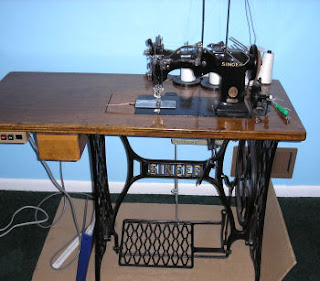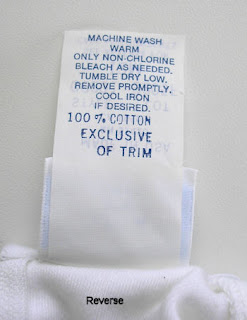 This is my Singer 72w-19 Hemstitcher. It was made sometime in the 1940's - the exact date can't be determined because of lost manufacturing information. It was refurbished, complete with a new paint job, before I purchased it. It is in incredibly good condition. The curious thing is this industrial machine originally came as a treadle. I would have expected manufacturers to buy machines outfitted with motors in the 1940's. My machine has been retrofitted with a new, modern motor, but I can switch over to the treadle if the power were to go out.
This is my Singer 72w-19 Hemstitcher. It was made sometime in the 1940's - the exact date can't be determined because of lost manufacturing information. It was refurbished, complete with a new paint job, before I purchased it. It is in incredibly good condition. The curious thing is this industrial machine originally came as a treadle. I would have expected manufacturers to buy machines outfitted with motors in the 1940's. My machine has been retrofitted with a new, modern motor, but I can switch over to the treadle if the power were to go out.Speaking of power outages... Have you ever been stitching on an industrial machine when the power DID go out? Usually, there is enough reserve power to allow the operator to get the piece out of the machine. This is good because you don't want to leave pieces in a machine because of oil spotting. If the power stays off for more than a few hours, the operators usually get sent home. BUT, if the machines could be switched over to manual power, no lost productivity! There is a learning curve with manual treadles, and I certainly need more practice.
[back from sidetrack] I need to buy a rug and those plastic mover thingy's to put under the legs. It weighs a ton! The cardboard is meant to protect my carpet until I can get a rug.
Here is a close-up of the needle-assembly. You can see there are two needles and two punches. The pre-punch starts a hole. As the fabric moves through, the two needles move in a zig-zag type motion in tandem with a second punch. BTW, the punches are really called piercers. I prefer the term punches because the pierces do not cut the yarns of the fabric. Rather, they just move the yarns apart.
 When I first purchased the machine, I needed to have some minor adjustments made to improve the stitch quality. These types of machine, and especially the age, make it difficult to find mechanics willing to work on it. Even when new, each hemstitcher would have it's own unique "personality". A mechanic would have to adjust each machine until it stitched properly, which could be about a dozen possible minor adjustments. Over time, it's personality becomes more distinct. This translates into a lot of time for mechanics who have to tinker around with moving things as little as 1/16".
When I first purchased the machine, I needed to have some minor adjustments made to improve the stitch quality. These types of machine, and especially the age, make it difficult to find mechanics willing to work on it. Even when new, each hemstitcher would have it's own unique "personality". A mechanic would have to adjust each machine until it stitched properly, which could be about a dozen possible minor adjustments. Over time, it's personality becomes more distinct. This translates into a lot of time for mechanics who have to tinker around with moving things as little as 1/16".I ended up calling every sewing machine mechanic within a 500 mile radius. I finally found a hobbyist mechanic who specialized in old hemstitchers. He took the time to teach me how to make many of the adjustments myself, including proper threading. He was worth every penny! Plus, he has hard to find replacement parts. A true treasure.
The most difficult situation I now face is replacing the needles. The two needles need to be oriented just exactly right or I may end up with skipped stitches or broken threads. It is a task I dread, so I don't push the machine to its limits. It is capable of stitching 1300 SPM!
 I need to purchase a proper 3-spool thread stand. Here is my make-do set-up. The hanger stuck into an elastic spool works great for the bobbin winder.
I need to purchase a proper 3-spool thread stand. Here is my make-do set-up. The hanger stuck into an elastic spool works great for the bobbin winder.In case you are wondering what a hemstitcher does, here is a stitch sample. A hemstitcher creates holes, held open by the stitching. My stitch sample is done on flannels close to the edge. A crochet edging can then be applied as a decorative treatment. I have seen the hemstitching, itself, used as a decorative element on clothing and linens. There really are a lot of possibilities. I hemstitch baby flannel blankets and burp cloths for local customers.
BTW, modern embroidery machines can reproduce a hemstitch, but the quality can't even compare to the real thing. Also, it takes twice as long to stitch.





